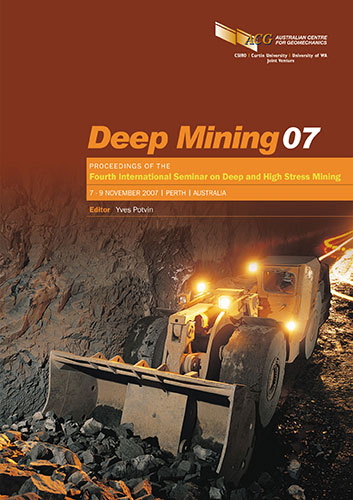Estimating the Probabaility of Mining-Induced Seismic Events using Mine-Scale, Inelastic Numerical Models

|
Authors: Beck, D; Reusch, F; Arndt, S |
DOI https://doi.org/10.36487/ACG_repo/711_2
Cite As:
Beck, D, Reusch, F & Arndt, S 2007, 'Estimating the Probabaility of Mining-Induced Seismic Events using Mine-Scale, Inelastic Numerical Models', in Y Potvin (ed.), Deep Mining 2007: Proceedings of the Fourth International Seminar on Deep and High Stress Mining, Australian Centre for Geomechanics, Perth, pp. 31-41, https://doi.org/10.36487/ACG_repo/711_2
Abstract:
Detailed, mine-scale non-linear numerical models have been calibrated using observations of displacement and damage at three deep mines. The calibrated models were then used to investigate the correlation between Dissipated Plastic Energy (DPE) and seismic event probability. A strong, non-linear relation between DPE and event probability was observed that describes the development, peak, and decline in seismicity as rock is deformed. The correlations are present for events at all magnitudes, and the where sufficient data was available for a comparison, a relation between DPE and event probability consistent with the relation between event magnitude and frequency described by the Gutenberg Richter equation was found. The application of DPE analysis during the design and sequencing of mines will allow a more quantitative description of seismic hazards than is currently available.
References:
Beck, D., Reusch, F., Arndt, S., Thin, I., Heap, M., Tyler, B. and Stone, C. (2006) Numerical modelling of seismogenic
development during cave initiation, propagation and breakthrough. Proceedings 3rd International Seminar on
Deep and High Stress Mining, Quebec, Canada, 2006.
Beck, D.A. and Brady, B.H.G. (2001) A numerical method for engineering management of induced seismic risk in hard
rock nining. Proceedings 5th International Symposium on Rockbursts and Seismicity in Mines, RaSiM5,
SAIMM, South Africa, G. van Aswegen, R.J. Durrheim, W.D. Ortlepp (eds), pp. 457-463.
Numerical Modelling
Deep Mining 07, Perth, Australia 41
© Copyright 2025, Australian Centre for Geomechanics (ACG), The University of Western Australia. All rights reserved.
View copyright/legal information
Please direct any queries or error reports to repository-acg@uwa.edu.au
View copyright/legal information
Please direct any queries or error reports to repository-acg@uwa.edu.au